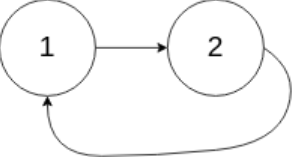2023/10/27大约 2 分钟
一、题目描述
给定一个链表的头节点head,返回链表开始入环的第一个节点。如果链表无环,则返回null。
如果链表中有某个节点,可以通过连续跟踪next指针再次到达,则链表中存在环。
为了表示给定链表中的环,评测系统内部使用整数pos来表示链表尾连接到链表中的位置(索引从0开始)。
如果pos是-1,则在该链表中没有环。注意:pos不作为参数进行传递,仅仅是为了标识链表的实际情况。
不允许修改链表。
示例 1
输入: head = [3, 2, 0, -4], pos = 1
输出: 返回索引为 1 的链表节点
解释: 链表中有一个环,其尾部连接到第二个节点。
示例 2
输入: head = [1, 2], pos = 0
输出: 返回索引为 0 的链表节点
解释: 链表中有一个环,其尾部连接到第一个节点。
示例 3
输入: head = [1], pos = -1
输出: 返回 null
解释: 链表中没有环。
提示
- 链表中节点的数目范围在范围
[0, 10⁴]内 -10⁵ <= Node.val <= 10⁵pos的值为-1或者链表中的一个有效索引
进阶
你是否可以使用O(1)空间解决此题?
相关主题
- 哈希表
- 链表
- 双指针
二、题解
ListNode(Rust)
type NLink = *mut ListNode;
pub struct ListNode {
pub val: i32,
pub next: NLink,
}
impl ListNode {
pub fn new(val: i32, next: NLink) -> NLink {
Box::into_raw(Box::new(ListNode { val, next }))
}
}ListNode(Java)
public class ListNode {
int val;
ListNode next;
public ListNode() {}
public ListNode(int val) {
this.val = val;
}
public ListNode(int val, ListNode next) {
this.val = val;
this.next = next;
}
}方法 1: 使用哈希表
Rust
pub fn detect_cycle(head: *mut ListNode) -> *mut ListNode {
let mut set = HashSet::new();
while !head.is_null() {
if !set.insert(head) {
return head;
}
unsafe {
head = (*head).next;
}
}
null_mut()
}Java
public ListNode detectCycle(ListNode head) {
HashSet<ListNode> set = new HashSet<>();
while (head != null) {
if (!set.add(head)) {
return head;
}
head = head.next;
}
return null;
}方法 2: 双指针
Rust
pub fn detect_cycle(head: *mut ListNode) -> *mut ListNode {
let mut fast = head;
let mut slow = head;
while !fast.is_null() {
unsafe {
fast = (*fast).next;
if fast.is_null() {
break;
}
fast = (*fast).next;
slow = (*slow).next;
if fast == slow {
fast = head;
while fast != slow {
fast = (*fast).next;
slow = (*slow).next;
}
break;
}
}
}
fast
}Java
public ListNode detectCycle(ListNode head) {
ListNode slow = head;
ListNode fast = head;
while (fast != null) {
fast = fast.next;
if (fast == null) {
break;
}
fast = fast.next;
slow = slow.next;
if (fast == slow) {
fast = head;
while (fast != slow) {
fast = fast.next;
slow = slow.next;
}
break;
}
}
return fast;
}